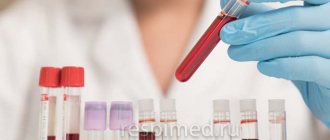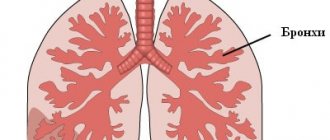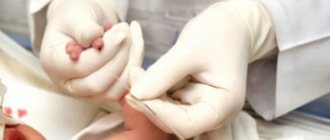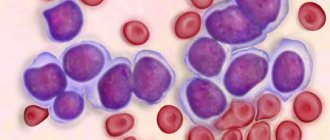Pneumonia is an acute disease that is accompanied by impaired lung function. The disease appears independently and as a complication, as a consequence of past illnesses.
Cells of bacteria, viruses, and fungi become pathogens. The reason for the development of the disease is weakened immunity and allergies.
Such conditions prevent the body's immune system from fighting pathogenic microbes on its own. A blood test helps determine the stage and type of pneumonia and prescribe an effective treatment plan.
Diagnosis of the disease at the initial stage
Identifying the disease at an early stage helps to avoid its progression and complications. Early diagnosis is of particular importance for atypical types of pneumonia that arise as a result of damage to the body by fungi, mycoplasmas, and chlamydia. The following procedures allow you to find the initial stages of inflammation of lung tissue:
- polymerase chain reaction;
- complement fixation reaction (CFR);
- enzyme immunoassay (ELISA);
- determination of the titer of specific immunoglobulins.
A distinctive feature of the procedures is the ability to show the type of pathogen in aggravated forms of the disease. The results obtained may indicate changes in the body:
- The presence of IgM immunoglobulins, which confirms primary infection. An increase in the number of these cells indicates the development of pathology.
- The presence of IgG immunoglobulins indicates a prolonged course of inflammation.
- The absence of IgG and IgM immunoglobulins indicates the absence of infection.
To ensure the veracity of the research, doctors recommend conducting a secondary study at two-week intervals.
What indicators in adults indicate pneumonia?
Previously, indicators by which one can determine the development of the inflammatory process in the lungs have already been touched upon. However, to complete the picture, it is worth identifying obvious clinical indicators indicating the development of pneumonia:
- Segmental leukocytosis - an increase in the content of immature leukocytes over 5% of the norm. It is the increased number of immature cells that indicates activation of the immune system, which indicates the development of pathology and the presence of inflammation.
- Increased ESR - an alarming indicator is ESR levels reaching approximately 25 mm/h; if the disease has reached a severe form, this figure increases to 40-50 mm/h.
- Lymphocytosis - if pneumonia is of viral origin, the percentage of lymphocytes in the blood increases.
In addition to the above, do not forget about the decrease in hemoglobin, the increase in the content of red blood cells and reticulocytes.
How to prepare for tests
According to observations from practice, the results of blood fluid tests are often false positive. This is due to the neglect of the preparation rules by patients. To ensure that blood counts for pneumonia in children are accurate, you need to follow the following rules:
- Blood serum collection is performed on an empty stomach. Therefore, the last meal should be 8-9 hours before the procedure. In the morning you are only allowed to drink a glass of water.
- In a couple of days, remove fatty, fried, and salty foods from your diet.
- Avoid stress (physical, emotional) half an hour before the test.
- Avoid attending other tests before donating blood.
It is important to take into account that certain medications can change the results. When a patient is constantly taking any medications, this must be reported to the doctor who prescribed the blood donation.
Sources and reference materials
Click on the required document to download:
| # | File | file size |
| 1 | Laboratory and instrumental standards | 145 KB |
| 2 | Laboratory standards (blood, biochemical, feces, respiratory function, etc.) | 218 KB |
| 3 | Diagnosis of respiratory diseases. Hams | 9 MB |
| 4 | Diagnosis and treatment of community-acquired pneumonia. Infectious Diseases Society of America Guidelines | 833 KB |
| 5 | Diagnostic algorithms and protocols for providing medical care for pneumonia | 3 MB |
| 6 | Lung studies and major syndromes | 199 KB |
Tests for pneumonia in children
Diagnostic measures for pneumonia include laboratory tests and radiation diagnostics. The first type includes the following manipulations:
- clinical blood tests;
- biochemistry of blood fluid;
- Analysis of urine;
- microscopy of sputum fluid.
The radiological diagnostic method involves:
- radiography;
- fluorography;
- computed tomography;
- fluoroscopy.
The attending doctor prescribes tests according to the age of the little patient and the severity of the disease.
Distinctive features of diagnostics
Babies under 3 years of age belong to a special category of patients, so proper diagnosis requires following the following scheme:
- visual assessment of the baby’s health status;
- thorough examination by a pediatrician, tapping the sternum area, auscultation using a phonendoscope;
- general blood and urine tests.
An experienced doctor will detect pneumonia in a baby without testing. Diagnosis of pneumonia in children aged 4 to 10 years includes standard manipulations: auscultation of the lungs using a phonendoscope, tests of blood serum, urine, and sputum. If the results obtained do not allow for a full diagnosis, radiography is prescribed.
For children over 10 years of age, all appropriate diagnostic procedures are allowed. Sputum fluid examination is carried out only in older children. It is difficult to collect such biomaterial from babies, because they swallow it. The method allows you to identify the number of red blood cells, neutrophils and fibrin.
The results obtained make it possible to identify the causative agent of the pathology. However, it would be incorrect to call this method completely informative, because during the collection of biomaterial there is a possibility of microorganisms entering from the oral cavity.
Symptoms and signs
During the first 48 hours, the pneumonia pathogen may manifest itself as a common cold or flu. It is important to pay attention to each individual symptom and consult a doctor in time. Primary symptoms of pneumonia include:
- elevated temperature that lasts 2-3 days (up to 40 degrees);
- swelling of the nose, cyanosis (blueness of the wings of the nose);
- pale skin, swelling;
- pain in the chest, trachea, throat;
- chills;
- cough (dry, wet, paroxysmal, with mucous sputum, purulent secretion, with wheezing);
- shortness of breath, rapid heartbeat;
- general weakness and drowsiness.
There are the following factors that influence the development and progression of pneumonia:
- respiratory diseases: bronchitis, sinusitis, laryngitis, tonsillitis, tracheitis, diabetes mellitus, cancer, AIDS, caries, diseases of the cardiovascular system;
- vitamin deficiency (seasonal or chronic);
- hypothermia, overheating;
- stressful situations;
- bad habits (especially smoking and excessive alcohol consumption);
- recent surgical intervention;
- age under 5 years and after 65;
- lack of regular physical activity;
- being in poorly ventilated areas;
- contact with infected people;
- being in public places during an epidemic;
- taking medications that weaken the immune system;
- poor hygiene, infrequent hand washing.
Blood chemistry
Blood parameters in children with pneumonia according to general and biochemical analysis differ, according to the nature of occurrence, form and degree of the disease. At the same time, for children it is not possible to accurately differentiate them into groups indicating the type of pathogen (bacteria/viruses/fungi).
Monitoring changes in indicators in complicated forms in the case of unsuccessful antibiotic therapy helps to assess the dynamics of the inflammatory process.
Looking through the results obtained, the doctor pays main attention to the following blood test indicators for pneumonia:
- Total protein. In a healthy body, protein levels reach 65-85 g/l. During inflammation of the lung tissue, it does not change its values and remains within acceptable limits.
- Alpha and gamma globulins. They significantly exceed the norm, which confirms the body’s fight against the inflammatory process.
- Fibrinogen. Does not significantly exceed the permissible barrier.
- C-reactive protein. Is above normal.
- Lactate dehydrogenase (LDH). The indicator level is slightly higher than normal.
A typical sign of any inflammatory reaction, including pneumonia, is leukocytosis or an increase in the absolute total number of leukocytes. Such cells eliminate infection from the body. The number of cells can be normal (10-15 thousand) and significant (reach 45 thousand). Manifested leukocytosis reflects bacterial etiology.
In severe stages, the level of leukocytes may drop. A blood count in pneumonia with moderate leukocytes or a decrease in their number indicates a viral cause of the development of the disease.
Pathogens of pneumonia
The causative agents of pneumonia completely influence the course of the disease. Each infectious agent gives a different clinical picture. Based on the type of pathogen, pneumonia is divided into several types:
- viral pneumonia (rhinoviruses, adenoviruses, influenza viruses, parainfluenza, measles, rubella, whooping cough, cytomegalovirus infection);
- bacterial pneumonia (staphylococci, pneumococci, chlamydia, streptococci, Haemophilus influenzae, mycoplasma pneumoniae);
- fungal pneumonia (pathogens are fungi of the genus Candida, Pneumocystis, Aspergillus);
- helminth pneumonia (caused by parasites);
- mixed (when the pathogens are several pathogenic agents at once).
Erythrocyte sedimentation rate
In case of acute pneumonia, ESR is considered one of the main signs of the presence of the disease in a child’s body. In children, this indicator varies according to age. An increase in ESR during pneumonia in a child is one of the most characteristic signs. The speed can reach more than 30 mm/h. According to the age of the small patient, the erythrocyte sedimentation rate in children should be:
- for infants – 2-4 mm/h;
- for children under one year old – 3-10 mm/h;
- children from one year to 5 years – 5-11 mm/h;
- children from 6 to 14 years old – 4-12 mm/h.
Exceeding the normal value for age is considered a pathology; the doctor assesses the degree of increase in ESR and whether the change corresponds to the symptoms of the disease.
An increase in the indicator is typical for infectious diseases, this indicates adequate functioning of the immune system. Values several times higher than normal indicate an inflammatory process.

How to suspect asymptomatic pneumonia?
In the case of asymptomatic or latent pneumonia, instead of coughing and high fever, the patient may experience decreased mood, fatigue and shortness of breath. The person also experiences rapid breathing and problems with the ability to inhale - lack of air. The patient's skin color may change - the face becomes pale due to lack of oxygen. Another sign is a feeling of high temperature with low levels.
According to the clinical guidelines of the Ministry of Health of the Russian Federation, suspicion of pneumonia should arise if the patient has a fever in combination with complaints of acute cough, shortness of breath, sputum production and/or chest pain associated with breathing or coughing. Patients often complain of unmotivated weakness, fatigue, chills, and severe sweating at night. The development of pneumonia may be preceded by symptoms of damage to the upper respiratory tract (sore throat, runny nose, etc.).
Question answer
Everything you need to know about antibiotics. Infographics In elderly people, complaints characteristic of pneumonia may be absent. The clinical picture of the disease may include symptoms such as drowsiness or anxiety, confusion, anorexia, nausea, and vomiting. Often pneumonia in this category of patients “debuts” with symptoms of decompensation of chronic concomitant diseases (diabetes mellitus, chronic heart failure, etc.). Latent pneumonia can be observed in patients with weakened immune systems.









